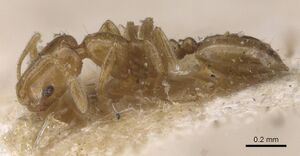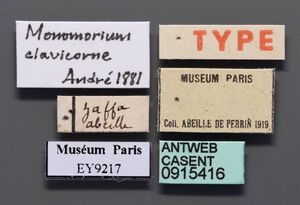Monomorium clavicorne
| Monomorium clavicorne | |
|---|---|

| |
| Scientific classification | |
| Kingdom: | Animalia |
| Phylum: | Arthropoda |
| Class: | Insecta |
| Order: | Hymenoptera |
| Family: | Formicidae |
| Subfamily: | Myrmicinae |
| Tribe: | Solenopsidini |
| Genus: | Monomorium |
| Species group: | monomorium |
| Species: | M. clavicorne |
| Binomial name | |
| Monomorium clavicorne André, 1881 | |
| Synonyms | |
| |
Sharaf, Al Dhafer et al. (2018): Little is known of the biology of the species. The single specimen available was found in a cultivated area with a sewage water stream. It was coexisting with Tapinoma simrothi, Trichomyrmex mayri and Tetramorium caespitum. Due to the relatively broad regional distribution of the species it might be an introduction to Saudi Arabia.
| At a Glance | • Limited invasive |
Identification
Keys including this Species
Distribution
Latitudinal Distribution Pattern
Latitudinal Range: 35.825556° to 35.825556°.
| North Temperate |
North Subtropical |
Tropical | South Subtropical |
South Temperate |
- Source: AntMaps
Distribution based on Regional Taxon Lists
Afrotropical Region: Saudi Arabia, United Arab Emirates.
Palaearctic Region: Israel (type locality), Oman, Tunisia (type locality), Türkiye.
Distribution based on AntMaps
Distribution based on AntWeb specimens
Check data from AntWeb
Countries Occupied
| Number of countries occupied by this species based on AntWiki Regional Taxon Lists. In general, fewer countries occupied indicates a narrower range, while more countries indicates a more widespread species. |

|
Estimated Abundance
| Relative abundance based on number of AntMaps records per species (this species within the purple bar). Fewer records (to the left) indicates a less abundant/encountered species while more records (to the right) indicates more abundant/encountered species. |

|
Biology
Castes
Worker
Images from AntWeb
   
| |
| Syntype of Monomorium clavicorne. Worker. Specimen code casent0915416. Photographer Will Ericson, uploaded by California Academy of Sciences. | Owned by MNHN, Paris, France. |
Nomenclature
The following information is derived from Barry Bolton's Online Catalogue of the Ants of the World.
- clavicorne. Monomorium clavicorne André, 1881b: 68, pl. 3, fig. 9 (w.) ISRAEL.
- Type-material: holotype (?) worker.
- [Note: no indication of number of specimens is given.]
- Type-locality: Israel: Jaffa (= Tel Aviv-Yafo) (Abeille de Perrin).
- Type-depository: MNHN.
- Combination in M. (Mitara): Santschi, 1915a: 58;
- combination in M. (Lampromyrmex): Wheeler, W.M. 1922a: 876.
- Subspecies of orientale: Mayr, 1904b: 4; Emery, 1908h: 685; Wheeler, W.M. 1922a: 876.
- Status as species: André, 1883a: 332 (in key); Dalla Torre, 1893: 66; Santschi, 1915a: 58; Emery, 1922e: 183; Menozzi, 1933b: 64 (in key); Ettershank, 1966: 88; Collingwood, 1985: 270; Kugler, J. 1988: 257; Bolton, 1995b: 260; Vonshak, et al. 2009: 43; Aldawood & Sharaf, 2011: 52 (in key); Collingwood, et al. 2011: 433; El-Hawagry, et al. 2013: 73 (in key); Borowiec, L. 2014: 117 (see note in bibliography); Sharaf, Al Dhafer, et al. 2018: 9 (redescription).
- Senior synonym of punicum: Sharaf, Al Dhafer, et al. 2018: 9.
- Distribution: Egypt, Iran, Israel, Lebanon, Morocco, Saudi Arabia, Sudan, Syria, Tunisia, Turkey, United Arab Emirates.
- punicum. Monomorium (Mitara) clavicorne var. punica Santschi, 1915a: 58, fig. 4 (w.) TUNISIA.
- Type-material: holotype worker.
- Type-locality: Tunisia: Sousse (Normand).
- Type-depository: NHMB.
- Combination in M. (Lampromyrmex): Emery, 1922e: 183.
- Subspecies of clavicorne: Emery, 1922e: 183; Ettershank, 1966: 91; Bolton, 1995b: 266.
- Junior synonym of clavicorne: Sharaf, Al Dhafer, et al. 2018: 9.
Description
References
- André, E. 1881c. Catalogue raisonné des Formicides provenant du voyage en Orient de M. Abeille de Perrin et description des espèces nouvelles. Ann. Soc. Entomol. Fr. (6)(1): 53-78 (page 68, pl. 3, fig. 9 worker described)
- Borowiec, L. 2014. Catalogue of ants of Europe, the Mediterranean Basin and adjacent regions (Hymenoptera: Formicidae). Genus (Wroclaw) 25(1-2): 1-340.
- Borowiec, L., Lapeva-Gjonova, A., Salata, S. 2023. Second record of Monomorium exiguum Forel, 1894 (Hymenoptera: Formicidae) from Europe. Annals of the Upper Silesian Museum in Bytom, Entomology 32 (online 007), 1-6 (doi:10.5281/ZENODO.10053329).
- Collingwood, C.A., Agosti, D., Sharaf, M.R., van Harten, A. 2011. Order Hymenoptera, family Formicidae. Arthropod fauna of the UAE 4: 405-474.
- Emery, C. 1908j. Beiträge zur Monographie der Formiciden des paläarktischen Faunengebietes. (Hym.) Teil V. Dtsch. Entomol. Z. 1908: 663-686 (page 685, Variety of orientale)
- Emery, C. 1922c. Hymenoptera. Fam. Formicidae. Subfam. Myrmicinae. [part]. Genera Insectorum 174B: 95-206 (page 183, Revived status as species)
- Kiran, K., Karaman, C. 2020. Additions to the ant fauna of Turkey (Hymenoptera, Formicidae). Zoosystema 42(18), 285-329 (doi:10.5252/zoosystema2020v42a18).
- Mayr, G. 1904b. Formiciden aus Ägypten und dem Sudan. In: Jägerskiöld, L. A. Results of the Swedish Zoological Expedition to Egypt and the White Nile, 1901. Part 1 (no. 9). Uppsala: Library of the Royal University of Uppsala, 11 pp. (page 4, Variety of orientale)
- Santschi, F. 1915a. Nouvelles fourmis d'Algérie, Tunisie et Syrie. Bull. Soc. Hist. Nat. Afr. Nord 6: 54-63 (page 58, Revived status as species)
- Sharaf, M. R., Wetterer, J. K., Mohamed, A. A., Aldawood, A. S. 2022. Faunal composition, diversity, and distribution of ants (Hymenoptera: Formicidae) of Dhofar Governorate, Oman, with updated list of the Omani species and remarks on zoogeography. European Journal of Taxonomy 838: 1-106 (doi:10.5852/ejt.2022.838.1925).
- Sharaf, M., Al Dhafer, H.M., Aldawood, A.S., Hita Garcia, F. 2018. Ants of the Monomorium monomorium species-group (Hymenoptera: Formicidae) in the Arabian Peninsula with description of a new species from southwestern Saudi Arabia. PeerJ 6:e4277, pp. 1-31 (DOI 10.7717/peerj.4277).
- Sharaf, M.R., Mohamed, A.A., Boudinot, B.E., Wetterer, J.K., Hita Garcia, F., Al Dhafer, H.M., Aldawood, A.S. 2021. Monomorium (Hymenoptera: Formicidae) of the Arabian Peninsula with description of two new species, M. heggyi sp. n. and M. khalidi sp. n. PeerJ 9, e10726. (doi:10.7717/peerj.10726).
- Wheeler, W. M. 1922j. Ants of the American Museum Congo expedition. A contribution to the myrmecology of Africa. VIII. A synonymic list of the ants of the Ethiopian region. Bull. Am. Mus. Nat. Hist. 45: 711-1004 (page 876, Combination in M. (Lampromyrmex))
References based on Global Ant Biodiversity Informatics
- Barech G., M. Khaldi, X. Espadaler, and H. Cagniant. 2017. The genus Monomorium Mayr, 1855 (Hymenoptera, Formicidae) in the Maghreb (North Africa): Identification key, redescription of Monomorium major Bernard, 1953 and new records from Algeria. Boletin de la Sociedad Entomológica Aragonesa 61: 151-157.
- Borowiec L. 2014. Catalogue of ants of Europe, the Mediterranean Basin and adjacent regions (Hymenoptera: Formicidae). Genus (Wroclaw) 25(1-2): 1-340.
- Collingwood C. A., D. Agosti, M. R. Sharaf, A. Van Harten, 2011. Order Hymenoptera, family Formicidae. Arthropod Fauna of the UAE 4: 405-474
- Collingwood C.A., D.Agosti, M.R. Sharaf, and A. van Harten. 2011. Order Hymenoptera, family Formicidae. Arthropod fauna of the UAE, 4: 405474
- Ettershank G. 1966. A generic revision of the world Myrmicinae related to Solenopsis and Pheidologeton (Hymenoptera: Formicidae). Aust. J. Zool. 14: 73-171.
- Ghahari H., and C. A. Collingwood. 2011. A study on the ants (Hymenoptera: Formicidae) of southern Iran. Calodema 176: 1-5.
- Ghahari H., and C. A. Collingwood. 2013. A study on the ants (Hymenoptera: Vespoidea: Formicidae) from Western Iran. Acta Phytopathologica et Entomologica Hungarica 48 (1): 155164.
- Santschi F. 1915. Nouvelles fourmis d'Algérie, Tunisie et Syrie. Bulletin de la Société d'Histoire Naturelle de l'Afrique du Nord 6: 54-63
- Santschi, F.. "Nouvelles fourmis d'Algérie, Tunisie et Syrie." Bulletin de la Société d' Histoire naturelle de l' Afrique du Nord 6 (1915): 54-63.
- Sharaf M., H. M. Al Dhafer, A. S. Aldawood, and F. Hita Garcia. 2018. Ants of the Monomorium monomorium species-group (Hymenoptera: Formicidae) in the Arabian Peninsula with description of a new species from southwestern Saudi Arabia. PeerJ 6:e4277; DOI 10.7717/peerj.4277
- Vonshak M., and A. Ionescu-Hirsch. 2009. A checklist of the ants of Israel (Hymenoptera: Formicidae). Israel Journal of Entomology 39: 33-55.
- Wheeler W. M. 1922. Ants of the American Museum Congo expedition. A contribution to the myrmecology of Africa. VIII. A synonymic list of the ants of the Ethiopian region. Bulletin of the American Museum of Natural History 45: 711-1004

